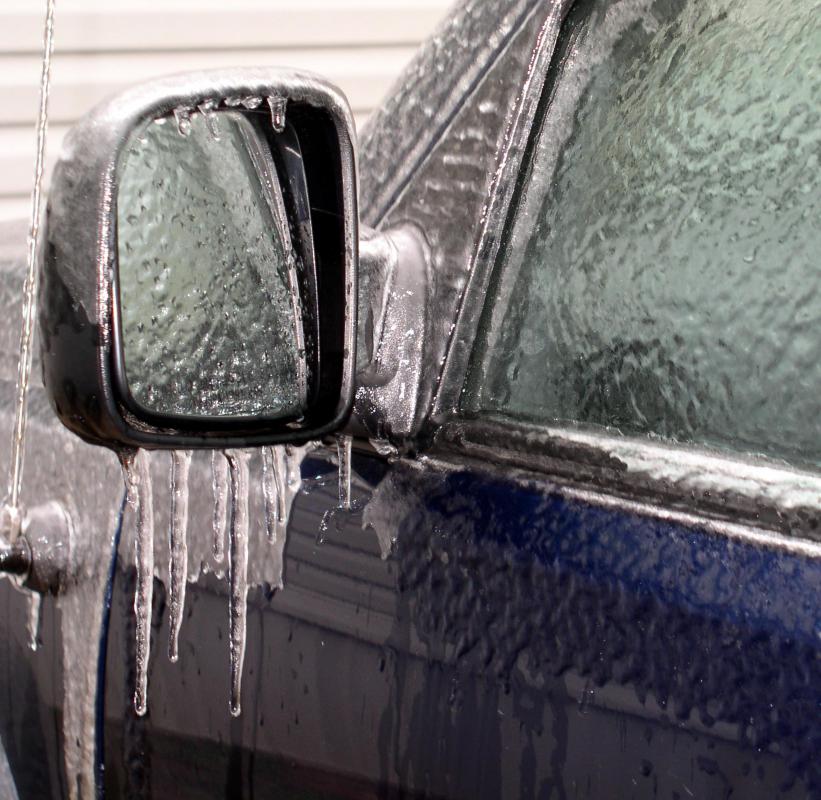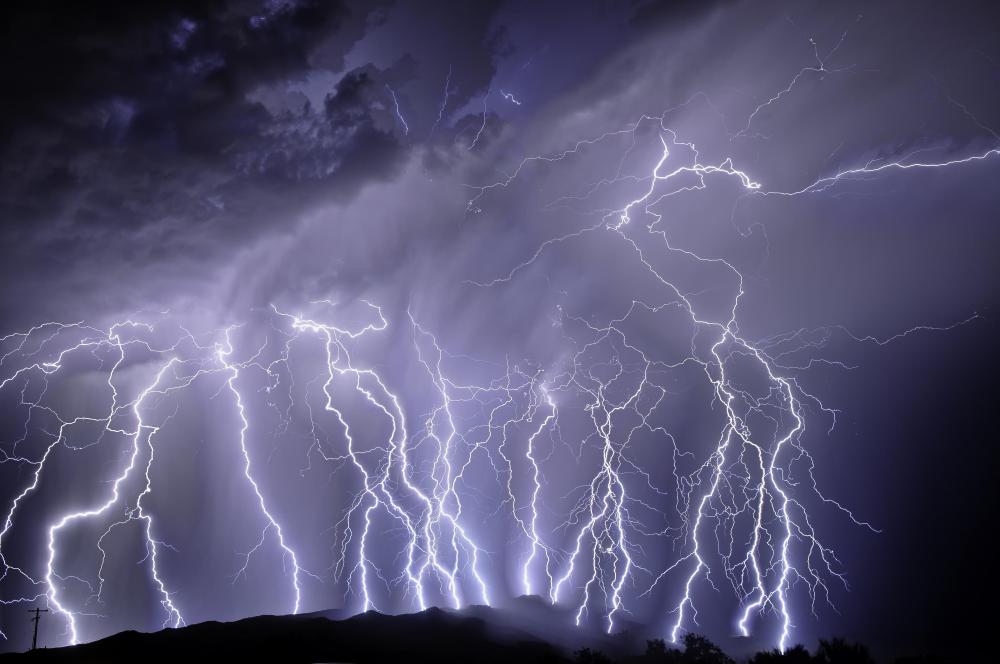At AllThingsNature, we're committed to delivering accurate, trustworthy information. Our expert-authored content is rigorously fact-checked and sourced from credible authorities. Discover how we uphold the highest standards in providing you with reliable knowledge.
What is the Difference Between Sleet and Hail?
Sleet and hail have different properties, though they may look similar. They require different circumstances, weather conditions and seasons in order to be produced. Another category that should be compared to sleet and hail is freezing rain, which again has its own special conditions and characteristics. All three involve precipitation in the clouds, but each requires just the right set of circumstances to occur.
One difference between sleet and hail is the time of year in which each occurs. Typically, hail is most often a summer occurrence, while sleet occurs mostly in winter. You’re much more likely to see hail in warm and oppressive weather where a sudden thunderstorm occurs. In fact, you need cumulus clouds like thunderheads in order to produce hail.

Hail begins as raindrops at the bottom of clouds; "bottom" means those parts of the clouds that are closest to the earth’s surface. The action of updrafts sends raindrops toward the top of thunderheads, where the temperature is cool enough to cause the raindrops to freeze. The now frozen raindrops start to fall, but updrafts cause hail to swing up to the colder top of the clouds several times. Each time this occurs, hail accumulates more water from the lower clouds, which is then frozen to create layers. If it happens often enough, you might see huge pieces of hail fall to earth. More typically it goes through a few cycles and looks like pea-sized pieces when it hits the ground.

Sleet and hail may look similar, but the formation of sleet is quite different, and explains why sleet is more often a winter phenomenon. Clouds that might produce sleet are warmer than the air below, and don’t have significant updrafts. In fact when sleet falls from clouds it is still rain.
The temperature of the air, as rain falls from the clouds is cold enough to freeze it on the way down. Therefore sleet doesn’t freeze in upper cumulus, but instead freezes in the air. Sleet won’t be large since it doesn’t accumulate extra layers of frozen water. Instead, when it falls it looks quite small, like tiny glittering diamonds. It usually melts quickly, because the air on the ground is warmer than air a few feet up.

A phenomenon separate from sleet and hail is freezing rain. This is also typically a winter occurrence, but it requires freezing temperatures on the ground instead of in midair where hail freezes. Freezing rain tends to remain rain until it hits the ground, where it instantly hardens and creates a sheet of ice on the ground. Of the three types, freezing rain is often more dangerous to motorists than is sleet and hail. Due to low ground temperature, ice layers on the ground may remain for several hours to several days, creating slippery roads and very unsafe driving conditions.
Frequently Asked Questions
What is the main difference between sleet and hail?

Sleet and hail are both forms of precipitation, but they form under different weather conditions. Sleet occurs when raindrops freeze into ice pellets before reaching the ground, typically during winter storms. Hail, on the other hand, forms in thunderstorms when updrafts carry raindrops into extremely cold areas of the atmosphere, causing them to freeze and accumulate layers of ice before falling.
How does the size of sleet compare to that of hail?

Sleet particles are generally small, with diameters of less than 5 millimeters. They are more like ice pellets or frozen raindrops. Hailstones, however, can range from pea-sized (about 5 millimeters) to as large as grapefruits (over 100 millimeters in diameter). The size of hail is a direct result of the strength of the updrafts in a thunderstorm.
Can sleet cause as much damage as hail?
While sleet can accumulate and create slippery surfaces, leading to hazardous driving conditions, it typically does not cause the same level of damage as hail. Hail can cause significant damage to crops, vehicles, and buildings due to its larger size and the force with which it falls. According to the National Weather Service, hail causes approximately $1 billion in damage to property and crops annually in the United States.
What time of year is sleet most common, and when is hail most likely to occur?
Sleet is most common in the winter months when temperatures are cold enough to freeze raindrops before they hit the ground. Hail, conversely, is more likely to occur during the spring and summer months, especially in the central and southern regions of the United States where thunderstorms are more frequent and intense.
Is it possible for sleet and hail to occur during the same weather event?
It is uncommon for sleet and hail to occur simultaneously because they form under different atmospheric conditions. Sleet is associated with winter weather systems, while hail is produced by strong thunderstorms with powerful updrafts. However, a thunderstorm could theoretically produce hail followed by sleet if temperatures near the ground are below freezing.
How do meteorologists predict the likelihood of sleet or hail in weather forecasts?
Meteorologists use radar technology, satellite data, and atmospheric models to predict the likelihood of sleet or hail. They analyze temperature profiles of the atmosphere, the strength of updrafts in thunderstorms, and the presence of supercooled water droplets. These tools help forecasters to issue warnings and advisories to inform the public about potential severe weather events, including sleet and hail.
AS FEATURED ON:
AS FEATURED ON:















Discussion Comments
O.K. Here's one to twist your turbans. When the April 27, 2011 tornadoes hit Alabama, the storm that hit Tuscaloosa had a lot of debris in it, obviously. By the time it got to Jasper, about 100 miles away, much of that debris had been carried into the upper levels of the atmosphere, where the air was below freezing. It had already been through the heavy rain in the storm and as a result, froze when it got to the upper atmosphere. People in Jasper reported "hail sticks" that were six to twelve inches long. They were sticks coated in ice after being up in the storm system. True story. You can check out ABC channel 33 in Birmingham for verification. They ran a story with photos. One of the weirdest things I've ever seen.
What a great article. I knew there was a difference between hail and other forms of winter precipitation, but I never knew there was a difference between sleet and freezing rain. I thought they were simply interchangeable names for the same thing.
Whatever the winter weather, it seems like the weather has become much less predictable as of late. I normally don't put my winter tires on my vehicle until November first since it's not good for your vehicle to run those tires on dry pavement. This year I was caught out in the rain, so to speak. We had a freak snowstorm in the middle of October that dumped two feet of snow on higher elevations, but only sleet and freezing rain at lower elevations. My car slid off the road, so I had my winter tires put on early. Ever since it has been mid 60’s every day, and no snow in sight. Go figure right.
@ Anon46886- Gropple or Grauple as it is technically referred to, is a combination of snow and rime. This type of snow usually only occurs during the beginning and end months of winter as well as the mid-winter thaw. The temperature and atmospheric conditions have to produce super cooled moisture that remains liquid as well as snowflakes. As the snowflakes swirl around in the atmosphere before falling, they collect microscopic drops of super cooled liquid water that instantly freeze to the snowflakes. The result is a dense but fragile bead of snow ta falls to the earth that we call grauple.
Grauple can be particularly dangerous when it falls on alpine climates. Grauple is much denser than regular snow, but it packs in a less stable fashion. Because it is essentially 2-5 millimeter balls of snow accretion, the structure is unstable. They crumble easily and have low moisture content for their size. This can cause sheet avalanches when a storm produces a large enough layer of grauple, or grauple is followed by a considerable amount of normal snow.
Where does gropple fit in?
Post your comments